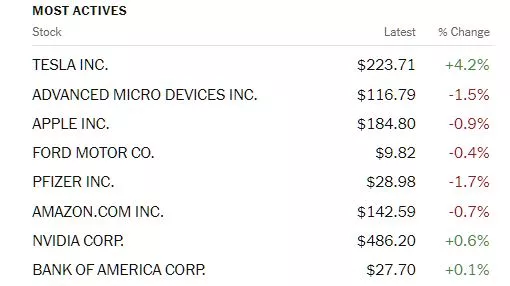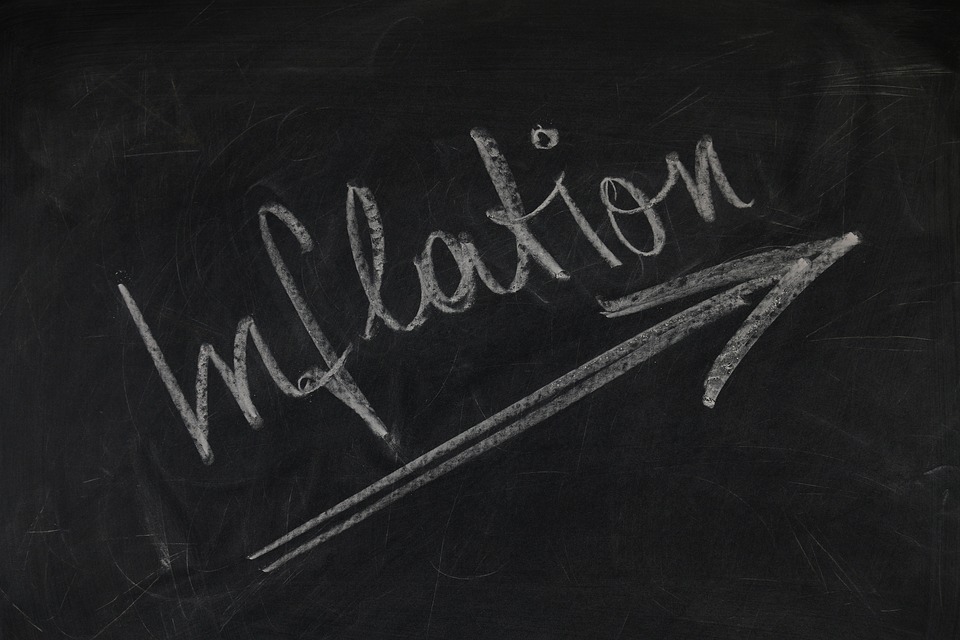The stock market rallied last week. The S&P 500 closed 51 points higher, the Dow closed 191 points higher, and the Nasdaq Composite closed 284 points higher. But is the rally real? FreepikYesterday after faltering in the morning on the news of the Moody’s credit downgrade, the market recovered and closed at around Friday’s levels. The S&P 500 closed at 4412, down four points, the Dow closed at 34,338, up 55 points, and the Nasdaq Composite close at 13768, down 30 points.
FreepikYesterday after faltering in the morning on the news of the Moody’s credit downgrade, the market recovered and closed at around Friday’s levels. The S&P 500 closed at 4412, down four points, the Dow closed at 34,338, up 55 points, and the Nasdaq Composite close at 13768, down 30 points. Chart: The New York TimesMost actives were led by Tesla (TSLA), up 4.2%, followed by Advanced Micro Devices (ADM), down 1.5% and Apple (AAPL), down 0.9%.
Chart: The New York TimesMost actives were led by Tesla (TSLA), up 4.2%, followed by Advanced Micro Devices (ADM), down 1.5% and Apple (AAPL), down 0.9%. Chart: The New York TimesIn morning futures trading S&P 500 market futures are up 4 points, Dow market futures are up 7 points, and Nasdaq 100 market futures are up 34 points.The Staff at Schiff Gold explains why Moody’s Lowers US Credit Outlook To “Negative”.”On Friday, Moody’s Investor Service lowered its outlook on US government credit from “stable” to “negative.” This could be a prelude to a downgrade in the country’s AAA credit rating. The agency typically resolves an outlook by either revising it back to stable or executing an actual downgrade within 18 to 24 months.Credit ratings represent an agency’s assessment of the country’s ability to make good on its debt obligations.Moody’s cited rising interest rates and the lack of political will to address the national debt as reasons for the outlook change.
Chart: The New York TimesIn morning futures trading S&P 500 market futures are up 4 points, Dow market futures are up 7 points, and Nasdaq 100 market futures are up 34 points.The Staff at Schiff Gold explains why Moody’s Lowers US Credit Outlook To “Negative”.”On Friday, Moody’s Investor Service lowered its outlook on US government credit from “stable” to “negative.” This could be a prelude to a downgrade in the country’s AAA credit rating. The agency typically resolves an outlook by either revising it back to stable or executing an actual downgrade within 18 to 24 months.Credit ratings represent an agency’s assessment of the country’s ability to make good on its debt obligations.Moody’s cited rising interest rates and the lack of political will to address the national debt as reasons for the outlook change.
In the context of higher interest rates, without effective fiscal policy measures to reduce government spending or increase revenues, Moody’s expects that the US’ fiscal deficits will remain very large, significantly weakening debt affordability.”
Moody’s also expressed concern about the “ongoing political polarization within US Congress,” saying it will hinder the ability to “reach consensus on a fiscal plan to slow the decline in debt affordability.”Moody’s is the last of the three major rating agencies to maintain a top AAA rating for the US government debt.This move by Moody’s follows a rating downgrade from AAA to AA+ by Fitch in August.“The repeated debt-limit political standoffs and last-minute resolutions have eroded confidence in fiscal management,” Fitch said at the time, noting that the US government doesn’t have any kind of “medium-term fiscal framework,” and operates under a “complex budgeting process. In other words, Congress sets the budget on a year-by-year basis…The Moody’s outlook downgrade occurs as the US government stands on the brink of another government shutdown. The current stopgap funding deal reached before the last deadline runs through Nov. 17…The average interest rate on the debt now stands at the highest level since 2011, coming in at 2.92% as of the end of August. But that’s still relatively low, and the debt is more than double what it was back in the good ol’ days of 2011.Meanwhile, the average interest rate is poised to climb rapidly. A lot of the debt currently on the books was financed at very low rates before the Federal Reserve started its hiking cycle. Every month, some of that super-low-yielding paper matures and has to be replaced by bonds yielding much higher rates. That means interest payments will quickly climb much higher unless rates fall.To give you an idea of where we’re heading, T-bills currently yield about 5.5%, the two-year yield is over 5% and the 10-year currently yields close to 5%.Rising interest rates drove interest payments to over 35% of total tax receipts. In other words, the government is already paying more than a third of the taxes it collects on interest expense.If interest rates remain elevated, or continue rising, interest expenses could climb rapidly into the top three federal expenses. You don’t need a Ph.D. in math or economics to recognize that the downward credit outlook revision By Moody’s was warranted. In fact, it seems almost absurd that the agency still maintains a AAA rating on US debt.” PixabayIn a TalkMarkets Editor’s choice column, contibutor Dean Baker asks Should We Be Worried About The Deficit Now?”The shrieks of the deficit hawks have been growing louder with the fiscal 2023 deficit crossing 6.0 percent of GDP, and the projected future deficits being no lower. With interest rates now close to or above GDP growth, we regularly hear about the story of a looming debt spiral, where high debt leads to high interest payments, which add to annual deficits, making the debt even larger…We did see a surge in inflation in 2021 and 2022. Part of that story was too much demand, due to the generous pandemic support from the federal government, however, the real story was the supply problems associated with the pandemic. Whatever excess demand problem we had went away when the programs ended, and supply recovered after the end of the pandemic.In any case, that history is behind us, the question is whether there is good reason to believe that we are seeing excess demand now. There are still important questions about the future course of inflation, but it has fallen quite rapidly over the last year and is virtually certain to fall further.Wage growth has also slowed to a pace that is close to its growth rate before the pandemic when inflation was at the Fed’s 2.0 percent target. Other measures of the labor market, like quit rates and unemployment insurance claims, are at levels that are consistent with a strong labor market, but well below/above the levels seen when the labor market was very tight in the spring of 2022.In short, it is certainly not clear that deficit-driven demand is so strong that it is causing inflation…Some of the deficit hawks raise the prospect of a crisis of confidence, where investors suddenly become unwilling to hold U.S. debt and interest rates go through the roof and the dollar goes through floor. There are certainly examples of countries where this has happened, but not in situations where they had an otherwise healthy economy, as is the case with the United States…It is worth noting that the U.S. debt to GDP ratio is not exceptionally high by international standards. The ratio of debt to GDP in France and the United Kingdom is very comparable to the U.S. and in Italy and Japan it is far higher. In fact, using gross debt, a measure that includes debt to public pension funds, Japan has a debt-to-GDP ratio of 260 percent. The current interest rate on long-term Japanese bonds is less than 1.0 percent…There are areas where we desperately need to spend more money. The expanded child tax credit that Biden put in place with his recovery plan should be brought back. We also need to have additional funding for child care to make it affordable. And, we have a massive problem of homelessness.This list could be extended at some length, but the point is that there is no urgency for reducing the deficit. We have many other problems that need to be addressed, which will require additional resources. This will mean making space in the economy by raising taxes, but the focus should be on addressing real problems in society, not reducing the deficit.”See the full article for more information.
PixabayIn a TalkMarkets Editor’s choice column, contibutor Dean Baker asks Should We Be Worried About The Deficit Now?”The shrieks of the deficit hawks have been growing louder with the fiscal 2023 deficit crossing 6.0 percent of GDP, and the projected future deficits being no lower. With interest rates now close to or above GDP growth, we regularly hear about the story of a looming debt spiral, where high debt leads to high interest payments, which add to annual deficits, making the debt even larger…We did see a surge in inflation in 2021 and 2022. Part of that story was too much demand, due to the generous pandemic support from the federal government, however, the real story was the supply problems associated with the pandemic. Whatever excess demand problem we had went away when the programs ended, and supply recovered after the end of the pandemic.In any case, that history is behind us, the question is whether there is good reason to believe that we are seeing excess demand now. There are still important questions about the future course of inflation, but it has fallen quite rapidly over the last year and is virtually certain to fall further.Wage growth has also slowed to a pace that is close to its growth rate before the pandemic when inflation was at the Fed’s 2.0 percent target. Other measures of the labor market, like quit rates and unemployment insurance claims, are at levels that are consistent with a strong labor market, but well below/above the levels seen when the labor market was very tight in the spring of 2022.In short, it is certainly not clear that deficit-driven demand is so strong that it is causing inflation…Some of the deficit hawks raise the prospect of a crisis of confidence, where investors suddenly become unwilling to hold U.S. debt and interest rates go through the roof and the dollar goes through floor. There are certainly examples of countries where this has happened, but not in situations where they had an otherwise healthy economy, as is the case with the United States…It is worth noting that the U.S. debt to GDP ratio is not exceptionally high by international standards. The ratio of debt to GDP in France and the United Kingdom is very comparable to the U.S. and in Italy and Japan it is far higher. In fact, using gross debt, a measure that includes debt to public pension funds, Japan has a debt-to-GDP ratio of 260 percent. The current interest rate on long-term Japanese bonds is less than 1.0 percent…There are areas where we desperately need to spend more money. The expanded child tax credit that Biden put in place with his recovery plan should be brought back. We also need to have additional funding for child care to make it affordable. And, we have a massive problem of homelessness.This list could be extended at some length, but the point is that there is no urgency for reducing the deficit. We have many other problems that need to be addressed, which will require additional resources. This will mean making space in the economy by raising taxes, but the focus should be on addressing real problems in society, not reducing the deficit.”See the full article for more information. PixabayContributor Tommi Johnsen, PhD asks Is Inflation Ever Going To Go Down?”How long will it take for the current level of inflation to subside? If history is any guide, it could take quite a while. Across 198 policy interest rate hikes of at least 1%, a decrease of 1% in inflation took 2 to 4 years… If inflation surges, how long, on average, will it take to subside to a reasonable target rate of 2%?…(The results of research into the topic may surprise you). A recent research paper looks at a dataset that included fourteen developed markets (OECD), judged as a relevant comparison to extrapolate from the historical record. The period covered nearly 53 years of data for each country, from January 1970 to September 2022. The aftermath for each country was examined once it exceeded a 4% inflation rate. That criteria was modest and considered helpful for excluding incidents where the economy was recovering from deflation. The results provided a surprisingly useful barometer for evaluating the future path of inflation in the US. Will inflation prove to be transitory at this point in time?
PixabayContributor Tommi Johnsen, PhD asks Is Inflation Ever Going To Go Down?”How long will it take for the current level of inflation to subside? If history is any guide, it could take quite a while. Across 198 policy interest rate hikes of at least 1%, a decrease of 1% in inflation took 2 to 4 years… If inflation surges, how long, on average, will it take to subside to a reasonable target rate of 2%?…(The results of research into the topic may surprise you). A recent research paper looks at a dataset that included fourteen developed markets (OECD), judged as a relevant comparison to extrapolate from the historical record. The period covered nearly 53 years of data for each country, from January 1970 to September 2022. The aftermath for each country was examined once it exceeded a 4% inflation rate. That criteria was modest and considered helpful for excluding incidents where the economy was recovering from deflation. The results provided a surprisingly useful barometer for evaluating the future path of inflation in the US. Will inflation prove to be transitory at this point in time?
Using the historical record as a guide, labeling the future path of inflation in the US as transitory is possible but bears little resemblance to a central expectation. A quote from the authors:
We are reminded of lyrics by The Who: “I’ll get on my knees and pray we don’t get fooled again.” Of course, for those who take the time to study history, prayer has nothing to do with it. It was a mistake for the Fed to declare inflation transitory when it was rising rapidly; history tells us that, even at a modest 4% rate, it often is not transitory…
TalkMarkets contributor MN Gordon looks at The War And Peace Of Secular Market Cycles.”Investors and money managers may be underestimating the potential for the Israel-Hamas war spilling over into a greater regional or global conflict.Certainly, the fulfillment of this prospect would have severe consequences for human death and destruction. It would also accelerate the U.S. governments debt spiral and wreak havoc on financial markets.By this, we posit that during the initial fog of a geopolitical crisis, financial markets don’t have the faintest inkling of potential risk.Perhaps the latest row in Gaza will be another slow-moving conflict that enriches defense contractors and adds to the U.S. government’s massive debt pile. That’s the experience over the last several decades – demonstrated by wars in Iraq, Afghanistan, and even Ukraine.But what if there’s more to this story? Will the risk of a stock or bond market selloff be quickly overshadowed by the prospect of something much greater? Could the hellish self-annihilation of civilization be just moments away?…The question, in this regard, is how financial markets behave when a burgeoning geopolitical crisis hits. Obviously, there are plenty of other macroeconomic factors involved. But taking what can be observed for what it is, bond markets have been quick to dismiss a potential aftermath of significant capital destruction.The day of the Hamas sneak attack was Saturday October 7. Using market close on October 6 as our starting point, the yield on the 10-Year Treasury has declined from 4.78 to 4.63. The fear premium – as bond prices move inverse to yield – has been less than zero. Similarly, the price of a barrel of West Texas Intermediate crude has fallen from $82.79 to $75.59.The stock market, as measured by the S&P 500, sold off in late October and has since recovered. The S&P 500 is now about the same as it was on October 6.Defense sector stocks like Lockheed Martin have been the real winners. Since October 6, LMT is up 41 points – or over 10 percent. Up until October 6, LMT was down 17 percent for the year. The latest boost has brought its year-to-date return to minus 7 percent.Gold, while exhibiting more caution than Treasuries, is up roughly 7 percent since October 6. Most of the increase occurred between October 9 and October 27, with gold topping $2,000 per ounce. Since then, it has given back about $50 per ounce.In short, with a possible exception for gold, the fear premium across various markets just over one month from onset of what could be a major war is generally nowhere to be found. What to make of it?…Conflict escalation and spillover in the Middle East financed via the printing press is certainly a great big giant risk. This would further the long-term accumulation of gross financial imbalances that have occurred over the last 50 years.Many people don’t understand this or won’t acknowledge it. The impending financial collapse is too uncomfortable to even consider. There’s a general unwillingness to recognize the financial maelstrom that has been building for several generations.The specifics as to how it all goes down and when are uncertain. The reality of this prospect, however, should not be discounted.We close out the column in the “Where To Invest Department” with an update from TM contributor Lorimer Wilson of munKNEE.com, Israel-Hamas War News: Top 15 Israeli-Based US-Traded Stocks Continue To Slide.
Have a good one.Peace.More By This Author:Thoughts For Thursday: Staying On Top – Barely
Tuesday Talk: Market Is Up, But Uncertainty Lingers
Thoughts For Thursday: Grinding Higher













Leave A Comment